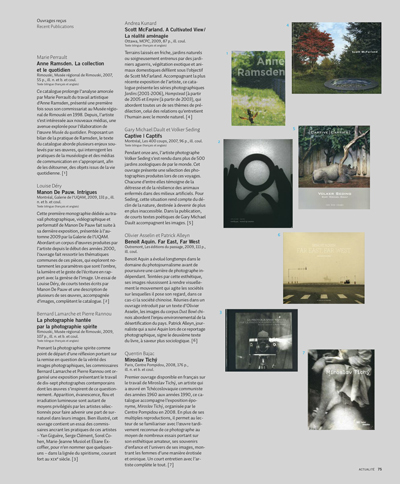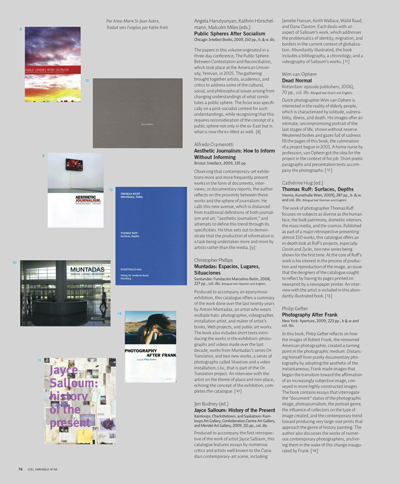[Printemps 2010]
Marie Perrault
Anne Ramsden. La collection et le quotidien
Rimouski, Musée régional de Rimouski, 2007,
55 p., ill. n. et b. et coul.
Texte bilingue (français et anglais)
Ce catalogue prolonge l’analyse amorcée par Marie Perrault du travail artistique d’Anne Ramsden, présenté une première fois sous son commissariat au Musée régional de Rimouski en 1998. Depuis, l’artiste s’est intéressée aux nouveaux médias, une avenue explorée pour l’élaboration de l’œuvre Musée du quotidien. Proposant un bilan de la pratique de Ramsden, le texte du catalogue aborde plusieurs enjeux soulevés par ses œuvres, qui interrogent les pratiques de la muséologie et des médias de communication en s’appropriant, afin de les détourner, des objets issus de la vie quotidienne.
Louise Déry
Manon De Pauw. Intrigues
Montréal, Galerie de l’UQAM, 2009, 131 p., ill. n. et b. et coul.
Texte bilingue (français et anglais)
Cette première monographie dédiée au travail photographique, vidéographique et performatif de Manon De Pauw fait suite à sa dernière exposition, présentée à l’automne 2009 par la Galerie de l’UQAM. Abordant un corpus d’œuvres produites par l’artiste depuis le début des années 2000, l’ouvrage fait ressortir les thématiques communes de ces pièces, qui explorent notamment les paramètres que sont l’ombre, la lumière et le geste de l’écriture en rapport avec la genèse de l’image. Un essai de Louise Déry, de courts textes écrits par Manon De Pauw et une description de plusieurs de ses œuvres, accompagnée d’images, complètent le catalogue.
Bernard Lamarche et Pierre Rannou
La photographie hantée par la photographie spirite
Rimouski, Musée régional de Rimouski, 2009, 107 p., ill. n. et b. et coul.
Texte bilingue (français et anglais)
Prenant la photographie spirite comme point de départ d’une réflexion portant sur la remise en question de la vérité des
images photographiques, les commissaires Bernard Lamarche et Pierre Rannou ont organisé une exposition présentant le travail de dix-sept photographes contemporains dont les œuvres s’inspirent de ce questionnement. Apparition, évanescence, flou et irradiation lumineuse sont autant de moyens privilégiés par les artistes sélectionnés pour faire advenir une part de surnaturel dans leurs images. Bien illustré, cet ouvrage contient un essai des commissaires ancrant les pratiques de ces artistes – Yan Giguère, Serge Clément, Sorel Cohen, Marie-Jeanne Musiol et Éliane Excoffier, pour n’en nommer que quelques-uns – dans la lignée du spiritisme, courant fort au XIXe siècle.
Andrea Kunard
Scott McFarland. A Cultivated View / La réalité aménagée
Ottawa, MCPC, 2009, 87 p., ill. coul.
Texte bilingue (français et anglais)
Terrains laissés en friche, jardins naturels ou soigneusement entrenus par des jardiniers aguerris, végétation exotique et animaux domestiques défilent sous l’objectif de Scott McFarland. Accompagnant la plus récente exposition de l’artiste, ce catalogue présente les séries photographiques Jardins (2001-2006), Hampstead (à partir de 2005 et Empire (à partir de 2003), qui abordent toutes un de ses thèmes de prédilection, celui des relations qu’entretient l’humain avec le monde naturel.
Gary Michael Dault et Volker Seding
Captive | Captifs
Montréal, Les 400 coups, 2007, 96 p., ill. coul.
Texte bilingue (français et anglais)
Pendant onze ans, l’artiste photographe Volker Seding s’est rendu dans plus de 500 jardins zoologiques de par le monde. Cet ouvrage présente une sélection des photographies produites lors de ces voyages. Chacune d’entre elles témoigne de la détresse et de la résilience des animaux enfermés dans des milieux artificiels. Pour Seding, cette situation rend compte du déclin de la nature, destinée à devenir de plus en plus inaccessible. Dans la publication, de courts textes poétiques de Gary Michael Dault accompagnent les images.
Olivier Asselin et Patrick Alleyn
Benoit Aquin. Far East, Far West
Outremont, Les éditions du passage, 2009, 111 p., ill. coul.
Benoit Aquin a évolué longtemps dans le domaine du photojournalisme avant de poursuivre une carrière de photographe indépendant. Teintées par cette esthétique, ses images réussissent à rendre visuellement le mouvement qui agite les sociétés sur lesquelles il pose son regard, dans ce cas-ci la société chinoise. Réunies dans un ouvrage introduit par un texte d’Olivier Asselin, les images du corpus Dust Bowl chinois abordent l’enjeu environnemental de la désertification du pays. Patrick Alleyn, journaliste qui a suivi Aquin lors de ce reportage photographique, signe le deuxième texte du livre, à saveur plus sociologique.
Quentin Bajac
Miroslav Tichý
Paris, Centre Pompidou, 2008, 176 p.,
ill. n. et b. et coul.
Premier ouvrage disponible en français sur le travail de Miroslav Tichý, un artiste qui a œuvré en Tchécoslovaquie communiste des années 1960 aux années 1990, ce catalogue accompagne l’exposition éponyme, Miroslav Tichý, organisée par le Centre Pompidou en 2008. En plus de ses multiples reproductions, il permet au lecteur de se familiariser avec l’œuvre tardivement reconnue de ce photographe au moyen de nombreux essais portant sur son esthétique amateur, ses souvenirs d’enfance et l’univers de ses images, montrant les femmes d’une manière érotisée et onirique. Un court entretien avec l’artiste complète le tout.
Angela Harutyunyan, Kathrin Hörschelmann, Malcolm Miles (eds.)
Public Spheres After Socialism
Chicago: Intellect Books, 2009, 150 pp., b. & w. ills.
The papers in this volume originated in a three-day conference, The Public Sphere: Between Contestation and Reconciliation, which took place at the American University, Yerevan, in 2005. The gathering brought together artists, academics, and critics to address some of the cultural, social, and philosophical issues arising from changing understandings of what constitutes a public sphere. The focus was specifically on a post-socialist context for such understandings, while recognizing that this requires reconsideration of the concept of a public sphere not only in the ex-East but in what is now the ex-West as well.
Alfredo Cramerotti
Aesthetic Journalism: How to Inform Without Informing
Bristol: Intellect, 2009, 135 pp.
Observing that contemporary-art exhibitions more and more frequently present works in the form of documents, interviews, or documentary reports, the author reflects on the proximity between these works and the sphere of journalism. He calls this new avenue, which is distanced from traditional definitions of both journalism and art, “aesthetic journalism,” and attempts to define this trend through its specificities. He thus sets out to demonstrate that the production of information is a task being undertaken more and more by artists rather than the media.
Christopher Phillips
Muntadas: Espacios, Lugares, Situaciones
Santander: Fundación Marcelino Botín, 2008, 227 pp., col. ills.
Bilingual text (Spanish and English).
Produced to accompany an eponymous exhibition, this catalogue offers a summary of the work done over the last twenty years by Antoni Muntadas, an artist who wears multiple hats: photographer, videographer, installation artist, and maker of artist’s books, Web projects, and public art works. The book also includes short texts introducing the works in the exhibition: photographs and videos made over the last decade, works from Muntadas’s series On Translation, and two new works, a series of photographs called Situations and a video installation, Lloc, that is part of the On Translation project. An interview with the artist on the theme of place and non-place, echoing the concept of the exhibition, completes the catalogue.
Jen Budney (ed.)
Jayce Salloum: History of the Present
Kamloops, Charlottetown, and Saskatoon: Kamloops Art Gallery, Confederation Centre Art Gallery, and Mendel Art Gallery, 2009, 111 pp., col. ills.
Produced to accompany the first retrospective of the work of artist Jayce Salloum, this catalogue features essays by numerous critics and artists well known to the Canadian contemporary-art scene, including Jamelie Hassan, Keith Wallace, Walid Raad, and Dana Claxton. Each deals with an aspect of Salloum’s work, which addresses the problematics of identity, migration, and borders in the current context of globalization. Abundantly illustrated, the book includes a bibliography, a chronology, and a videography of Salloum’s works.
Wim van Ophem
Dead Normal
Rotterdam: episode publishers, 2006),
70 pp., col. ills.
Bilingual text (Dutch and English).
Dutch photographer Wim van Ophem is interested in the reality of elderly people, which is characterized by solitude, vulnerability, illness, and death. His images offer an intimate, uncompromising portrait of the last stages of life, shown without reserve. Weakened bodies and gazes full of sadness fill the pages of this book, the culmination of a project begun in 2001. A home nurse by profession, van Ophem got the idea for the project in the context of his job. Short poetic paragraphs and presentation texts accompany the photographs.
Cathérine Hug (ed.)
Thomas Ruff: Surfaces, Depths
Vienna, Kunsthalle Wien, 2009), 287 pp., b. & w. and col. ills.
Bilingual text (German and English).
The work of photographer Thomas Ruff focuses on subjects as diverse as the human face, the built patrimony, domestic interiors, the mass media, and the cosmos. Published as part of a major retrospective presenting almost 150 works, this catalogue offers an in-depth look at Ruff’s projects, especially Cassini and Zycles, two new series being shown for the first time. At the core of Ruff’s work is his interest in the process of production and reproduction of the image, an issue that the designers of the catalogue sought to reflect by having its pages printed on newsprint by a newspaper printer. An interview with the artist is included in this abundantly illustrated book.
Philip Gefter
Photography After Frank
New York: Aperture, 2009, 223 pp., b & w and col. ills.
In this book, Philip Gefter reflects on how the images of Robert Frank, the renowned American photographer, created a turning point in the photographic medium. Distancing himself from purely documentary photography by adopting the aesthetic of the instantaneous, Frank made images that began the transition toward the affirmation of an increasingly subjective image, conveyed in more highly constructed images. The book contains essays that interrogate the “document” status of the photographic image, photojournalism, the portrait genre, the influence of collectors on the type of image created, and the contemporary trend toward producing very large-size prints that approach the genre of history painting. The author also discusses the works of numerous contemporary photographers, anchoring them in the wake of this change inaugurated by Frank.
Traduit vers l’anglais par Käthe Roth


